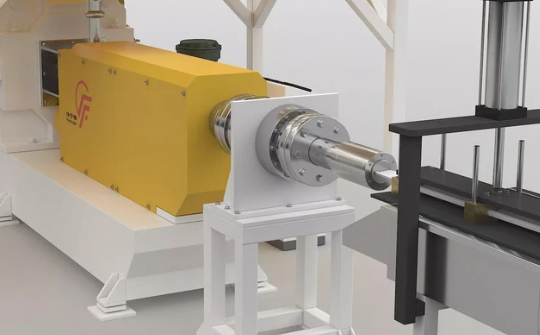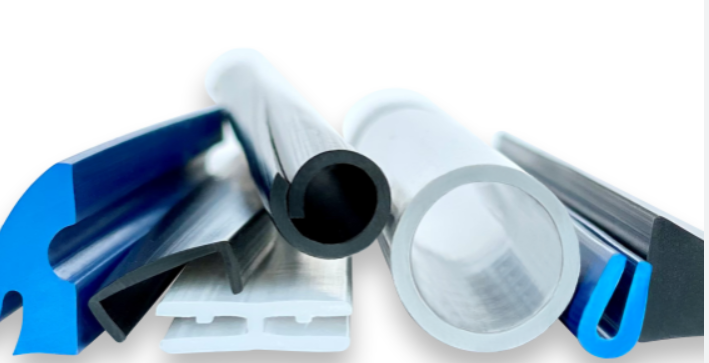Extrusion is generally cheaper than injection molding for continuous, simple profiles, but costs vary based on volume and complexity.

Understanding Extrusion
The Extrusion Process Explained
Extrusion is a manufacturing process where a material, often a thermoplastic or metal, is pushed through a die to create a shape with a constant cross-section. Unlike other manufacturing techniques, extrusion can continuously produce long lengths of product. The process starts with feeding the raw material into a hopper, which then goes into a heated barrel. Here, a rotating screw pushes the material through the barrel, where it gets melted due to heat and pressure. The molten material then exits through a die, taking the shape of the desired profile. This process is highly efficient for mass production of items like pipes, tubes, and sheets. The power requirements for an extrusion machine depend on its size and complexity, typically ranging from 15 kW to 500 kW.
Applications and Materials for Extrusion
Extrusion is versatile, suitable for a wide range of materials including plastics like polyethylene, PVC, and ABS, as well as metals like aluminum and copper. This process is essential in producing a variety of products, from construction materials like window frames and railings to everyday items like plastic bags and tubing. The selection of material impacts the quality, speed, and cost of production. For instance, extruding PVC profiles might cost around $0.20 to $0.50 per foot depending on the complexity and size of the profile.
Exploring Injection Molding
Basics of Injection Molding
Injection molding involves injecting molten material into a mold to create parts with complex shapes and high detail. This process begins with melting plastic granules and injecting them into a mold cavity under high pressure. Once the material cools and solidifies, the mold opens to eject the finished part. Key parameters in this process include pressure, which can range from 35 to 140 MPa, and the clamping force required to keep the mold closed, typically between 125 and 5,000 tons. Injection molding is known for its high production speed, with cycle times as short as 15 seconds for small components.
Materials and Products in Injection Molding
Injection molding is ideal for a variety of plastics like polystyrene, nylon, polypropylene, and thermoplastic rubber. It’s widely used in automotive, consumer electronics, and medical industries for products like bumpers, mobile phone cases, and syringes. The choice of material significantly affects the product’s characteristics, such as flexibility, strength, and resistance to heat or chemicals. For example, using high-quality nylon can increase the cost but provides better durability and heat resistance for automotive components. A typical medium-sized injection molding machine may have a cost ranging from $20,000 to $50,000, depending on specifications and capabilities.
Cost Analysis: Extrusion vs. Injection Molding
Initial Investment and Setup Costs
When comparing extrusion and injection molding, the initial investment varies significantly due to equipment and tooling costs.
- Extrusion:
- Equipment cost for a standard extrusion line can range from $25,000 to $400,000, depending on the size, complexity, and capability of the machine.
- Additional tooling, such as dies and cutters, typically costs between $2,000 and $10,000.
- Setting up an extrusion line requires a physical space of adequate size, potentially adding to the initial cost if new premises are needed.
- Injection Molding:
- The cost of an injection molding machine ranges widely based on its size and complexity, from $10,000 for a small desktop unit to over $500,000 for a large, high-volume model.
- Mold costs are significant, often ranging from $1,000 for a simple mold to $100,000 for a complex, multi-cavity mold.
- Injection molding also necessitates a larger initial investment in terms of space and supporting infrastructure compared to extrusion.
Operating and Maintenance Expenses
The ongoing costs for both processes include labor, energy, maintenance, and material costs.
- Extrusion:
- Energy costs are a major factor, with an average extrusion machine consuming approximately 0.5 to 1.5 kWh per pound of material processed.
- Maintenance costs are relatively lower in extrusion and can be estimated at around 1-3% of the equipment cost annually.
- Labor costs are generally lower as the process requires less manual intervention once set up.
- Injection Molding:
- Injection molding machines are more energy-intensive, with energy consumption ranging from 2 to 5 kWh per pound of material.
- Maintenance costs are higher, usually around 5-10% of the equipment cost annually, due to the complexity of the machinery.
- Labor costs can be higher, as the process requires skilled operators for setup, monitoring, and maintenance.
Efficiency and Production Rates
Speed and Volume Comparisons
When comparing extrusion and injection molding in terms of speed and volume, several key factors stand out:
- Extrusion:
- Extrusion excels in continuous, high-volume production.
- Production speeds can vary, but a typical extrusion line can produce products at a rate of 2 to 50 feet per minute. This rate depends on the material and the complexity of the profile.
- Extrusion is ideal for long runs and is less effective for short production cycles due to the continuous nature of the process.
- Injection Molding:
- Injection molding is highly efficient for high-volume, discrete part production.
- Cycle times in injection molding are much shorter, typically ranging from 15 seconds to a few minutes, depending on part complexity and material.
- It is more flexible than extrusion for producing different designs and sizes, but requires longer setup times for mold changes.
Quality and Precision in Production
The quality and precision of products produced by extrusion and injection molding vary based on several factors:
- Extrusion:
- Provides consistent cross-sectional quality, essential for products like pipes and profiles.
- Tolerance levels in extrusion are generally broader compared to injection molding. Typical tolerances range from ±0.005 inches to ±0.030 inches, depending on the material and profile.
- Material selection impacts the precision and quality of the final product. For example, using high-grade aluminum can enhance the finish and dimensional accuracy of extruded profiles.
- Injection Molding:
- Offers high precision and repeatability, which is crucial for complex and intricate parts.
- Tolerances are tighter in injection molding, often within ±0.001 inches to ±0.005 inches, making it suitable for precision components in industries like medical and aerospace.
- The quality of injection molded parts is influenced by various factors, including mold design, material quality, and machine precision. Using advanced polymers like PEEK or Ultem can significantly improve the strength and thermal resistance of molded parts.

Environmental Impact and Sustainability
Energy Consumption in Each Process
The environmental footprint of extrusion and injection molding largely revolves around energy consumption:
- Extrusion:
- The energy consumption in extrusion varies based on the material and machine size but generally falls within the range of 0.5 to 1.5 kWh per pound of material.
- Modern extrusion machines with energy-efficient designs can reduce energy use, particularly those equipped with features like variable speed drives and advanced heating systems.
- Injection Molding:
- Injection molding typically consumes more energy, with estimates ranging from 2 to 5 kWh per pound of material.
- Energy-efficient injection molding machines, such as those with servo-driven hydraulics, can considerably lower energy consumption, sometimes by up to 50% compared to older models.
Waste Management and Recycling
Waste management and recycling practices are crucial for reducing the environmental impact of both processes:
- Extrusion:
- Extrusion often produces less waste, as the continuous process minimizes offcuts and scraps.
- Recycling in extrusion is relatively straightforward. Manufacturers can often directly reuse scrap material by regrinding and refeeding it into the extrusion process.
- Implementing closed-loop systems, where waste material is directly recycled in the same facility, further enhances sustainability.
- Injection Molding:
- Injection molding can produce more waste, primarily through sprues, runners, and rejected parts.
- Recycling in injection molding involves grinding the waste and reusing it, although this can sometimes affect the quality of the final product.
- Advancements in biodegradable plastics and eco-friendly materials are increasingly being adopted in injection molding to reduce environmental impact.
Case Studies and Industry Applications
Real-World Examples in Various Industries
Extrusion and injection molding play pivotal roles in various industries, each with unique applications:
- Extrusion:
- Construction Industry: In construction, extrusion is vital for producing PVC pipes, window frames, and siding. For example, a large-scale project might use extruded aluminum profiles for structural components, offering strength and durability.
- Automotive Industry: Car manufacturers utilize extrusion for creating rubber seals, hoses, and interior trim pieces. This process supports the need for continuous, uniform parts in large quantities.
- Injection Molding:
- Medical Industry: Injection molding is crucial in medical device manufacturing, where it’s used for making components like syringe barrels and surgical instrument handles. The process’s precision ensures adherence to strict medical standards.
- Consumer Electronics: In the consumer electronics industry, injection molding is used for encasing electronics, such as the polycarbonate body of a smartphone. This application demands high precision and aesthetic quality.
Innovations and Future Trends
Both processes are evolving with technological advancements and market demands:
- Extrusion:
- Sustainable Materials: The industry is shifting towards more sustainable materials like biodegradable plastics, reducing environmental impact.
- Smart Manufacturing: Integration of IoT (Internet of Things) technologies in extrusion lines allows for better process control, efficiency, and predictive maintenance.
- Injection Molding:
- 3D Printing Integration: Combining 3D printing with injection molding is on the rise, allowing for more complex and custom molds at a lower cost and shorter lead time.
- Advanced Materials: Use of advanced composite materials and high-performance polymers is expanding, especially in aerospace and automotive sectors, for lightweight and durable components.




